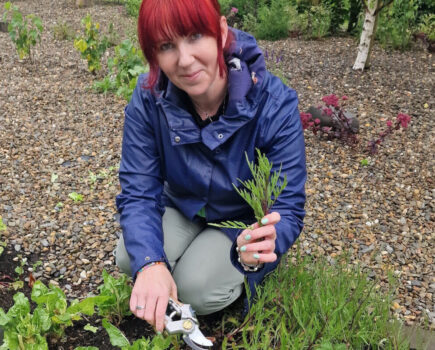Andrew Oldham shares his experiences of making the best use of apples and nasturtium remaining from the year’s harvest
The last of the apples are in the kitchen and I have been barking on about buying a fruit press for too long. No more mountains of apple pies and crumbles. I now have mountains of bottles that I have been collecting over the last few months. I have been told by numerous people to be meticulously clean when juicing. I have been told: ‘Beware of the bacteria’ like some 1950s B movie, ‘It kills!’ Bad cider smells of lemons or bananas, known as cider sickness and anyone mad enough to drink it won’t come out smelling of lemons or bananas.
The idea of poisoning us or the neighbours, has put me off making cider for years but as our orchard has grown and our apple yields have gone up, we have decided to have a go. The news travels fast in our hamlet and our Swedish neighbour has got wind of our plans to make cider. His head pops over our orchard wall as my wife, Carol and I harvest apples; two large trugs brimming with the tart ‘Keswick Codling’, the sweet ‘Fillingham’, the blush ‘Flower of the Town’ and ‘Hunt House’; the apple Captain Cook swore by. Our Swedish neighbour looks at the trugs full of apples and asks, ‘Are you making cider?’ How long does cider take to make?
A little more talk and an offer to assist and we realise that his ‘help’ comes in the shape of drinking the finished product. I must tell him that apples take a year to become cider. If I drank my juiced apples now, they would just be apple juice and by Christmas I will have something that will strip the non-stick off any pan. By Easter, next year, I will have a palatable drink with a tart kick but by summer, I will open a bottle, have a glass, think it’s not bad, stand up and fall headfirst into the flowerbed. Real cider once ready isn’t like cider in the pubs, it is a living drink that reminds you that the etiquette of any cider drinking takes place with you sat down.

Our Swedish neighbour looks disheartened, and he wanders off, he’s never gotten over the homemade rhubarb schnapps we gave him one year. No one in the hamlet who received a bottle from us walked straight that Christmas. Now we need to make the cider We take the apple harvest into the kitchen thinking juicing is easy. We spend thirty minutes chopping up apples to make a ‘mash’ which we cram into the press.
As Carol turns the handle we both realise that we may have misinterpreted what a ‘mash’ is. Our mash is like the raw mixture for apple pies. Muscles taut, faces sweating, Carol turns and I pin down the press. Surely it should be simpler than this? We look up what ‘mash’ should look like. Red faced, mainly from embarrassment, we ladle out the squashed apples and bash the hell out of it in a brewer’s bucket with a large piece of wood. That’s mash. We can press it now without fear of popping a blood vessel. The juice runs, sweet and cloudy.
We could stop here, bottle the juice after filtering it, add some citric acid to stop it from going off and pop it in the fridge but we have three demi-johns waiting. So, we start to decant and filter, watching the cloudy mixture settle inside and we add yeast, pop on an airlock and step back. Carol talks about making ginger beer at school, how no one wanted it, and a lad in her class took the lot home, hid it in his wardrobe, left it there until it exploded taking the wardrobe with it. We move the demi-johns into a large metal tray in the middle of the kitchen, if they explode, they have nowhere to go, nothing to destroy.
Home made brewing comes in many forms I am not new to brewing. My dad was a brewer of fine country wines, those hedgerow wines, those wines that when you sip allows the next words that come out of your mouth to be several octaves lower than before. Gooseberry wine, elderberry, orange, blackcurrant, wine made from his own grapes. Once we caught the dog underneath one of his kegs, on her back, catching the drips from a faulty tap, three sheets to the wind. Next month we will decant our first cider into bottles, adding sugar to a few to create sparkling cider, leaving the rest to be real cider, and agreeing that if worst comes to the worst we can mix with lemonade, which by the way, is my favourite way to drink cider with loads of ice. Sacrilege, I know.

Find more tips, advice and articles like this at the Amateur Gardening website. Subscribe to Amateur Gardening magazine now.





